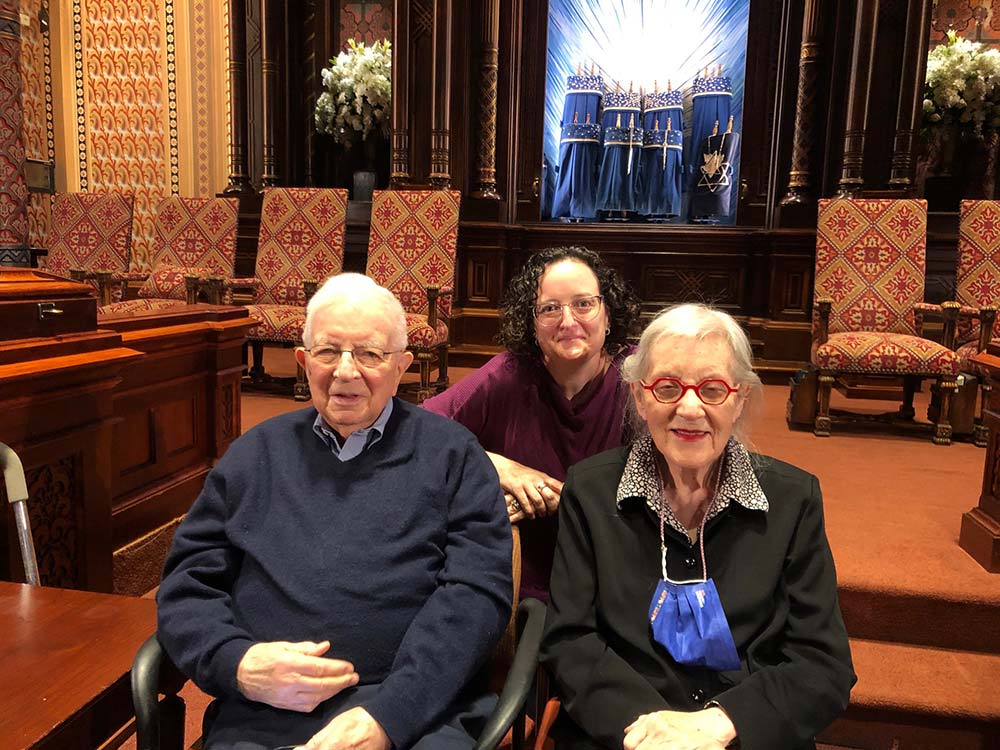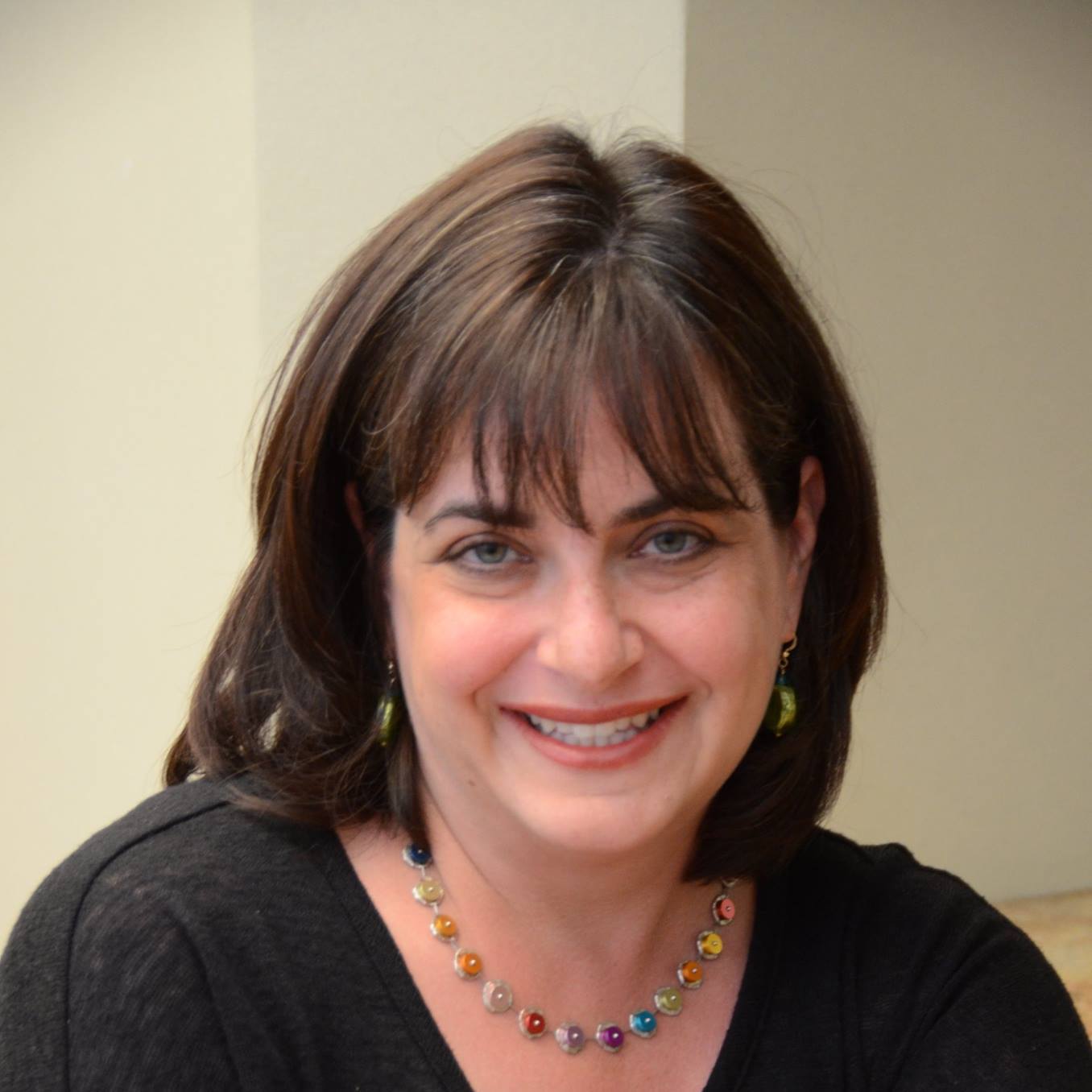In Grand Sanctuary, Holocaust Survivors Share Their Stories

On a Wednesday morning in New York in the fall of 2021, Rabbi Nicole Auerbach greeted Walter and Phyllis Loeb in Central Synagogue’s majestic sanctuary. She led them through the arch-lined nave, past row after row of pews, beyond the six sets of capital columns wrapped in colorful, gold-accented reliefs, all the way up to the intricately carved Mahagony bima, the stage where the synagogue’s rabbi and cantor preside over Shabbat and holiday services.
Rabbi Auerbach asked Walter to open the Ark to reveal the set of velvet-clad Torah scrolls standing tall against a radiant azure backdrop—a ritual that usually signals the most intense moments in a religious service. Today, however, the sanctuary was nearly empty and no prayers were being recited. But Rabbi Auerbach believed that Walter, then 97, was about to undertake a most sacred task.
For the next three hours, sitting on the bima flanked by the Ark behind him and a camera in front, Walter answered a long series of interview questions. He spoke about his family’s move from Frankfurt to Milan in 1936 after Hitler’s rise to power, when Walter was 11. He recounted his family’s expulsion from Italy and immigration to Cuba in 1939, followed, a few months later, by their move to New York. He spoke about graduating high school, and with pride about being drafted into the United States Army, landing on Utah Beach on D-Day in June 1944, and later thwarting a German plot to blow up a strategic bridge.
Walter Loeb’s testimony was recorded for USC Shoah Foundation’s Last Chance Testimony Collection, a race-against-time initiative to capture stories of Holocaust survivors. The initiative was launched in 2019 to capture and integrate thousands of new testimonies for the Visual History Archive, which contains more than 52,000 testimonies of Holocaust survivors and witnesses. (Learn more about the Last Chance Testimony Collection.)
But at-home interviews became extremely difficult during the COVID-19 pandemic, and, after a connection was made, Central Synagogue offered its spacious sanctuary for filming. Synagogue staff worked to coordinate film crews, make the sanctuary available, and schedule interviews, and members trained to conduct interviews. Over the past year, Central Synagogue has facilitated and helped fund 14 interviews, all but one taking place in the sanctuary. (The testimonies are still being processed for inclusion in the Visual History Archive.)
“It was a great feeling when I sat down in front of the open Ark. It felt like a very special occasion to be interviewed in such a manner,” Loeb said a few months after the interview. He and his wife have been members at Central Synagogue for 20 years, and attend weekly Shabbat services and Torah study classes at the Reform congregation in Midtown Manhattan. The day he recorded his interview was the first time he was back in the sanctuary since before the pandemic shutdown.
“It has been incredibly meaningful for both the interviewers and the survivors to tell their stories on the bima,” said Rabbi Auerbach, director of congregational engagement at the synagogue, which has 2,800 member units. “This is sacred work, and it is a way for us to serve the larger Jewish community. Our members are honored to be trusted with these stories.”
Rabbi Angela Buchdahl, Central Synagogue’s senior rabbi, said preserving Holocaust survivor stories aligns with the synagogue’s commitment to confront intolerance.
“We cannot understand today’s antisemitism without the context and resonance of our past experiences,’’ Buchdahl said.
A recent encounter with antisemitism made the point even stronger for Buchdahl.
In January, the rabbi was summoned to speak by phone to a gunman who was holding a rabbi and several congregants hostage at Congregation Beth Israel in Colleyville, Texas. The assailant believed Buchdahl, a high-profile rabbi, would have access to powerful lawmakers who could meet his demands.
“Antisemitism shape-shifts and mutates, like a virus, but the foundation of this bigotry has roots that go back many, many centuries,” Buchdahl said in an interview. “Survivors’ testimonies not only give witness to the horrors, but to the resilience of the Jewish people and their spirit. We are grateful to learn from their stories.”
(Listen to Rabbi Buchdahl’s speech following her encounter with the Texas hostage-taker.)
USC Shoah Foundation hopes its partnership with Central Synagogue can set an example for how other community-based institutions—houses of worship, schools, universities, and museums—can involve their membership in preserving oral histories and honoring survivors’ experiences.
Dr. Kori Street, Interim Finci-Viterbi Executive Director of USC Shoah Foundation, said this community based approach consistently reaps rich dividends.
"We do our work best when we engage with the community,” Dr. Street said. “Friends and family have been key to encouraging Holocaust survivors to tell their stories. We are always working to involve more people in collecting and sharing testimony and keeping these vital stories alive.”
The collaboration with Central Synagogue took root in the spring of 2021 when synagogue members Jill Sharfstein, a retired pre-school teacher with a strong interest in Holocaust history, and Nancy Fisher, a longtime interviewer for USC Shoah Foundation, approached Central Synagogue’s leadership about recording the testimony of member Anne Moradpour, who escaped Berlin on the Kindertransport in May, 1939.
“It is a form of resistance to do a Holocaust interview in this sanctuary, where you can’t help but feel the presence of a higher being,” said Fisher, who has conducted some 125 interviews for USC Shoah Foundation since 1996, including several in the Central Synagogue over the last year. “And there is also something obscene, almost heinous, about bringing the horrifying acts committed against the Jews into this sacred, safe space. But these stories must be told.”
Sharfstein attended the session when Fisher interviewed Moradpour, the first to be recorded in the sanctuary. Sharfstein was awed by Fisher’s small touches, such as bringing tissues, snacks and water for Moradpour, and asking her interviewee to bring along family artifacts to create a sense of intimacy. Sharfstein also observed Fisher’s gentle but searching questions, and her intense listening as Moradpour spoke.
“History came alive in that moment,” said Sharfstein. “We can never, of course, understand what it was like because we weren't there, but hearing from people who were there is so incredibly powerful and so important.”
Sharfstein’s first interview was with Walter Loeb. Now 98, Loeb still writes a weekly blog on the retail industry for Forbes Magazine, drawing from decades of experience in the field.
Loeb said he was at first reluctant to revisit the story of his teenage years, which were marred by the trauma of repeated displacement. But he knew he wanted to preserve his story for his three daughters and six grandchildren.
“It’s a very a difficult thing to go back in your history. It stirs up a lot of emotions,” Loeb said from his home in New York. “My philosophy is always to look ahead—where am I going next and what I am doing to create a better life for myself and my family.”
He said Sharfstein, whom he knew from synagogue, made him feel confident and supported, even within the grandeur of Central’s sanctuary.
“It’s a special kind of place to sit to tell your story” Loeb said, “and it just flowed.”
Contact USC Shoah Foundation about getting involved with the Last Chance Testimony Collection or to learn more about being interviewed.
Like this article? Get our e-newsletter.
Be the first to learn about new articles and personal stories like the one you've just read.
